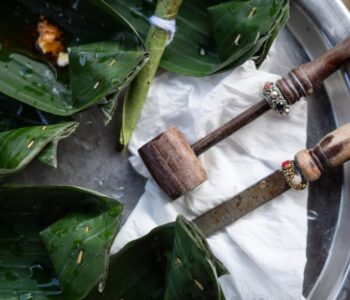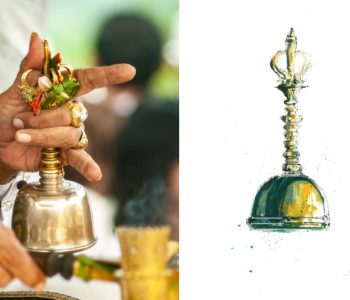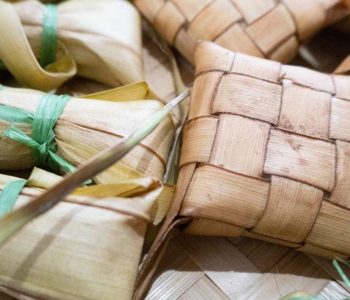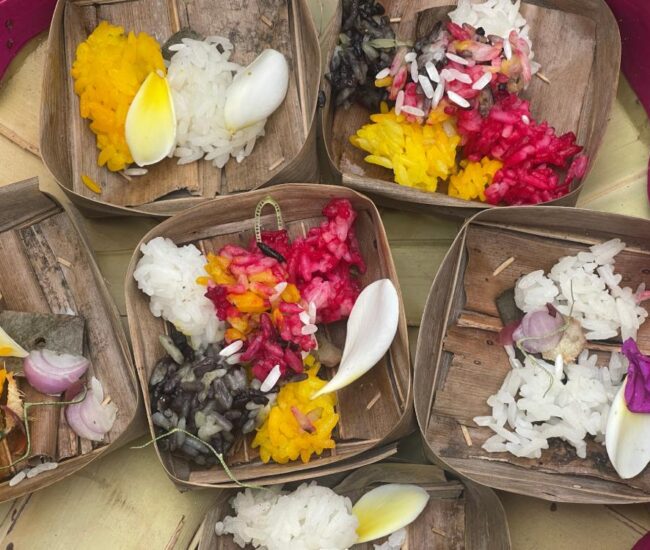Segehan: Offerings for the Bhuta Kala
The Balinese people, most of whom follow the Hindu religion, are never separated from yadnya ceremonies in their daily lives, which occur continuously for various purposes and functions. Each yadnya requires a specific banten or offering, and one of the simplest and smallest offerings—contrary to the misconception that Balinese ceremonies involve excessive use of materials—is segehan, which

Gayah: Bali’s Intricate Meat Offerings
Simultaneously unsightly and visually impressive, gayah are intricately-prepared offerings fashioned out of the meat, skin and parts of butchered pigs. Bali’s humid and tropical heat is certainly not the ideal condition for animal remains to be sweltering under the sun, but during major ceremonies, like funerals or odalan temple anniversaries, these gayah are necessary among the eclectic

Ulap-Ulap: The Protector of Balinese Buildings
Found hanging at the front of almost every Balinese building is a rerajahan (a form of religious art) known as an ulap-ulap. These ink drawings on white cloth serve to ward off misfortune from Balinese buildings. Ulap-ulap derives from the word ‘ulap’, meaning to wave or beckon. This refers to calling a particular positive force from

Pratima and Pralingga: Effigies of the Gods
Every year, the island of Bali comes alive with a profound and deeply spiritual tradition known as melasti. It is a ritual of purification, during which worshippers travel to the beach in procession. Carried upon their heads are special objects, often wrapped in sacred textiles. These are the pratima and pralingga, effigies symbolising gods and

Bija: Blessed Grains of Rice
Upon leaving the temple, grains of rice are often seen stuck to the forehead and necks of worshippers, both on women and men. This particular rice is called bija, and signifies being in a state of holiness. During worship ceremonies, Balinese Hindus not only receive tirta (holy water, referred to as nunas tirta), but also bija (referred

Kwangen: Bali’s Fragrant Offering
Balinese people are known for their meticulous attention to detail in their worship practices. There is a ceremony for so many aspects of life in Bali, and each ceremony will have very specific requirements. This is particularly true when it comes to certain rites and offerings, all must be executed with precision, all items present!

Piranti Mepandes: Tools of the Tooth Filing
One of the most significant rites of passage for any Balinese Hindu is the tooth filing ceremony, known as metatah, mesangih and for higher castes, mepandes. The ceremony involves the filing down of the top two canines and four incisors, the ‘fang-like’ teeth which are symbolic of the animalistic tendencies, as people enter the adult

Guide to Traditional Balinese Clothing: Symbolism, Meaning and What to Wear
Bali is known for its vibrant and visual living culture, and traditional attire is certainly part of this tapestry. Whether making their way to temples, hosting grand ceremonies, from weddings to blessings, there is very specific traditional Balinese clothing that must be worn, each different for men and women, and indeed depending on the type

Kulkul: A Traditional Balinese Slit Drum
One of the most remarkable aspects of the Balinese culture and traditions is the fact that, despite the ever-changing times and technology-driven world, many of them are still kept alive even today. An example of this is the “kulkul” or Balinese Slit Drum, an age-old traditional percussive device constructed out of wood or bamboo used

Genta: The Balinese Priest’s Sacred Bell
The piercing rings of the genta are heard at every ceremony, big or small. They are a ubiquitous sound in Bali, ringing in temples, roadsides, homes and even over the radio in Bali’s Puja Tri Sandhya, call to prayer. Held in the left hand of the Balinese Hindu priests, and accompanying the chants and mantras,

Lamak: Sacred Palm-Leaf Decorations
Often overshadowed by the piles of colourful offerings piled on top of them, it can be easy to miss the impressive palm leaf “tapestries” that decorate shrines, altars and even people during auspicious days and ceremonies. These colourful hanging accoutrements are called lamak, and serve as a foundation for offerings to attract deities and revered

Tipat and Bantal: Symbols of the Feminine and Masculine
Tipat and bantal are two elements that hold profound symbolic meaning within the context of Balinese Hindu beliefs and culture. If you are familiar with the unique ceremonies of Aci Tabuh Rah Pengangon (or Siat Tipat Bantal) and Mejauman (or Mepamit), you will know that these ceremonies all share a common trait: the inclusion of tipat and bantal. These

Gebogan: Bali’s Towered Offering
Gebogan is a traditional offering used during religious ceremonies, festivals, and other important occasions. It is one of Bali’s most eye-catching offerings, tall and colourful, with various fruits and flowers arranged into a tower. During certain ceremonies the gebogan are carried upon the heads of women in long procession (known as Mapeed), making for a




